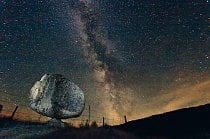EXCLUSIVE TO NATIONAL GEOGRAPHIC: ROLLING ROCKS

People gathered around a huge boulder, heads bowed, plant marigolds. It’s an annual custom, says Michelle Leger, a member of an extended family that regularly gathers in this public space in a small Massachusetts town to honor the tradition. She says the stone, called the Rollstone Boulder, is the pride of Fitchburg. “We’re fortunate to be able to beautify it – the way it deserves.”
Sure, but the three-foot boulder is impressive. But do rocks, even really big ones, really deserve anything? Either way, it’s clear that some of them have enthusiastic admirers. Stones like the Rollstone Boulder are called glacial erratic boulders. There are countless of them scattered around the planet.
Photographer Fritz Hoffmann became obsessed with the errant boulders when he wanted to read about random boulders on his property in Connecticut. And then, on a car trip in Massachusetts, he passed a signpost pointing the way to Plymouth Rock. “Wait! I wonder…’ He quickly turned around and parked at the Plymouth Visitor Center. “There’s one thing I’d like to ask you,” he said to the woman behind the counter, who was already preparing informational brochures for him. “Is Plymouth Rock a wandering rock?” “It was transported here by a glacier, if that’s what you’re asking,” she replied.
The journeys of errant boulders carried by glaciers during alternating ice ages were long, sometimes hundreds of miles. The boulders are also called eratic boulders or eratics. This name comes from the Latin errare, “to wander”, which makes sense, since the glacier carried them from their original location to where they are found today scattered across the northern part of the USA. On the prairies, the unusual rocks distort the wide horizon. Early Indian sculptors added buffalo ribs and hooves; later admirers painted them with paint, carved initials into them, and decorated them with plaques. In the forests, they are mysterious giants surrounded by trees. They balance on mountain tops as if perched there by some mischievous hand.


Source: National Geographic
Author: Editor | Published: 05.03.2012
